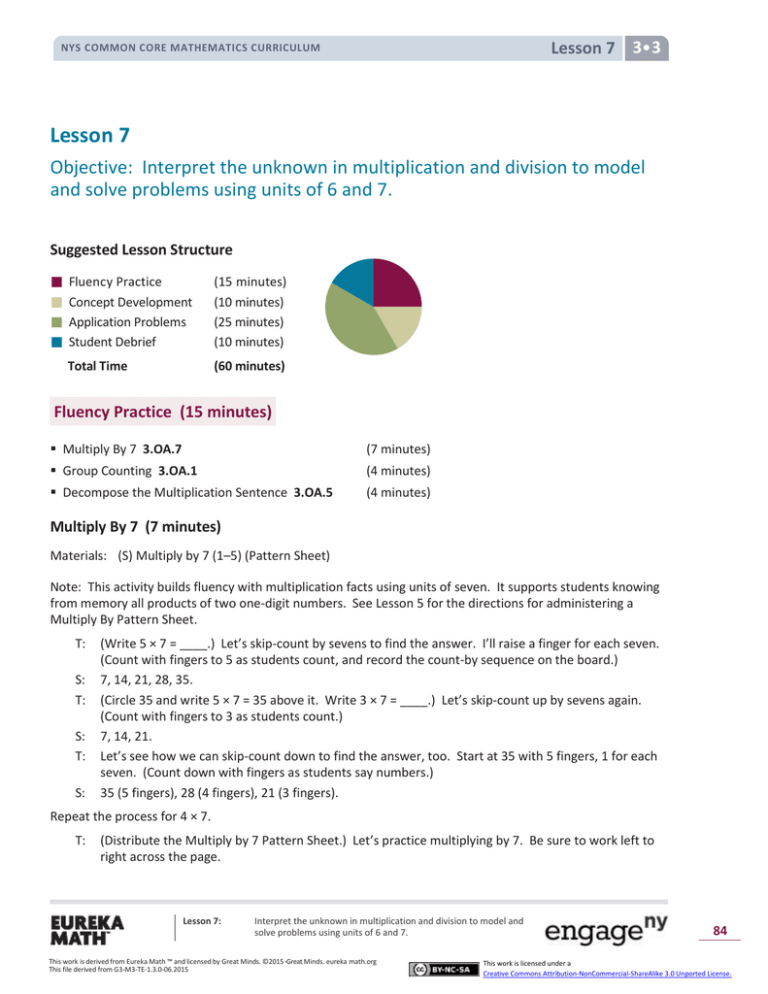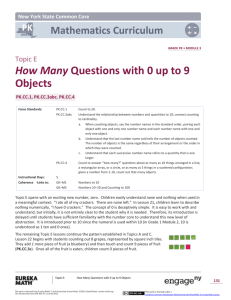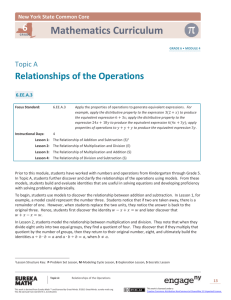Lesson 7 - EngageNY
advertisement

Lesson 7 3 3 NYS COMMON CORE MATHEMATICS CURRICULUM Lesson 7 Objective: Interpret the unknown in multiplication and division to model and solve problems using units of 6 and 7. Suggested Lesson Structure Fluency Practice Concept Development Application Problems Student Debrief Total Time (15 minutes) (10 minutes) (25 minutes) (10 minutes) (60 minutes) Fluency Practice (15 minutes) Multiply By 7 3.OA.7 (7 minutes) Group Counting 3.OA.1 (4 minutes) Decompose the Multiplication Sentence 3.OA.5 (4 minutes) Multiply By 7 (7 minutes) Materials: (S) Multiply by 7 (1–5) (Pattern Sheet) Note: This activity builds fluency with multiplication facts using units of seven. It supports students knowing from memory all products of two one-digit numbers. See Lesson 5 for the directions for administering a Multiply By Pattern Sheet. T: S: T: S: T: S: (Write 5 × 7 = ____.) Let’s skip-count by sevens to find the answer. I’ll raise a finger for each seven. (Count with fingers to 5 as students count, and record the count-by sequence on the board.) 7, 14, 21, 28, 35. (Circle 35 and write 5 × 7 = 35 above it. Write 3 × 7 = ____.) Let’s skip-count up by sevens again. (Count with fingers to 3 as students count.) 7, 14, 21. Let’s see how we can skip-count down to find the answer, too. Start at 35 with 5 fingers, 1 for each seven. (Count down with fingers as students say numbers.) 35 (5 fingers), 28 (4 fingers), 21 (3 fingers). Repeat the process for 4 × 7. T: (Distribute the Multiply by 7 Pattern Sheet.) Let’s practice multiplying by 7. Be sure to work left to right across the page. Lesson 7: Interpret the unknown in multiplication and division to model and solve problems using units of 6 and 7. This work is derived from Eureka Math ™ and licensed by Great Minds. ©2015 -Great Minds. eureka math.org This file derived from G3-M3-TE-1.3.0-06.2015 84 This work is licensed under a Creative Commons Attribution-NonCommercial-ShareAlike 3.0 Unported License. Lesson 7 3 3 NYS COMMON CORE MATHEMATICS CURRICULUM Group Counting (4 minutes) Note: Group counting reviews interpreting multiplication as repeated addition. Counting by sixes reviews multiplication using units of six in this topic and prepares students for today’s lesson. Group counting by eights and nines anticipates multiplication using those units later in the module. Direct students to count forward and backward, occasionally changing the direction of the count: Sixes to 60 Eights to 80 Nines to 90 NOTES ON MULTIPLE MEANS OF ACTION AND EXPRESSION: Decompose the Multiplication Sentence (4 minutes) Materials: (S) Personal white board Note: This activity reviews using the distributive property from Lesson 6. T: S: T: S: T: S: (Write 6 × 6 = (5 + __) × 6.) On your personal white board, copy and fill in the equation. (Write (6 × 6) = (5 + 1) × 6.) (Write = (__ × 6) + (__ × 6).) Copy and fill in the equation. (Write (5 × 6) + (1 × 6).) Write an addition equation. Below it, write your answer. (Write 30 + 6 and 36 below it.) Scaffold Decompose the Multiplication Sentence with pre-made sentence frames where students can simply fill in the blank, or solicit oral student responses only. Alternatively, model the equation while students draw number bonds or arrays. Continue with the following suggested sequence: 8 × 6, 7 × 6, and 9 × 6. (6 × 6) = (5 + 1) × 6 = (5 × 6) + (1 × 6) = 30 + 6 = 36 Concept Development (10 minutes) Materials: (S) Personal white board Thad sees 7 beetles when he weeds his garden. Each beetle has 6 legs. How many legs are there on all 7 beetles? T: S: T: Talk to a partner. What kind of picture can we draw to model this problem? We can draw 7 beetles, each with 6 legs. We can draw an array with 7 rows and 6 dots in each row. We can draw a tape diagram with 7 parts and 6 in each part. On your personal white board, draw and label a tape diagram to model this problem. Use the letter b for the beetles’ legs to represent the unknown. (Draw and label the tape diagram as shown.) Lesson 7: Interpret the unknown in multiplication and division to model and solve problems using units of 6 and 7. This work is derived from Eureka Math ™ and licensed by Great Minds. ©2015 -Great Minds. eureka math.org This file derived from G3-M3-TE-1.3.0-06.2015 85 This work is licensed under a Creative Commons Attribution-NonCommercial-ShareAlike 3.0 Unported License. Lesson 7 3 3 NYS COMMON CORE MATHEMATICS CURRICULUM T: S: T: What does the letter on your tape diagram represent? The unknown. The total number of legs on 7 beetles. Next to your tape diagram, write an equation for the problem and solve it. At the signal, show your board. (Signal after students write equation.) S: (Show 7 × 6 = b, b = 42.) T: Talk to a partner. What strategy did you use to find b? T: Write a sentence to answer the problem, and then NOTES ON read your sentence to a partner. MULTIPLE MEANS OF REPRESENTATION: If time allows, repeat the process with 48 ÷ 6, providing a Depending on the level of English context for the problem. Application Problems (25 minutes) Materials: (S) Problem Set (Page 2) During this time, students work together in groups to complete the second page of the Problem Set. When the group work is done, they meet with members of other groups to discuss answers and problem solving strategies. proficiency of English language learners, make the problems and discussion available in their first language, if possible. Alternatively, provide extra time, reduce the amount of work, provide sentence frames for discussion, and/or read the words in Problem 1 as students match it to the correct equation. MP.1 Divide students into groups of four. Each group is assigned a word problem to model and solve from Page 2 of the Problem Set. Depending on the class size, there may be multiple groups solving the same problem. Circulate and clear up any misconceptions as students work. After students have finished, bring the class back together and redistribute the students into new groups. New groups should be comprised of at least four students who each solved a different word problem. They then take turns discussing how their group solved their designated problem, paying special attention to the various strategies that were used. Allow 10 minutes for discussion. Problem Set (5 minutes) The second page of the Problem Set is designed to be completed in the group work activity, as described above. The first page of the Problem Set can be completed during this time. Lesson 7: Interpret the unknown in multiplication and division to model and solve problems using units of 6 and 7. This work is derived from Eureka Math ™ and licensed by Great Minds. ©2015 -Great Minds. eureka math.org This file derived from G3-M3-TE-1.3.0-06.2015 86 This work is licensed under a Creative Commons Attribution-NonCommercial-ShareAlike 3.0 Unported License. Lesson 7 3 3 NYS COMMON CORE MATHEMATICS CURRICULUM Student Debrief (10 minutes) Lesson Objective: Interpret the unknown in multiplication and division to model and solve problems using units of 6 and 7. The Student Debrief is intended to invite reflection and active processing of the total lesson experience. Invite students to review their solutions for the Problem Set. They should check work by comparing answers with a partner before going over answers as a class. Look for misconceptions or misunderstandings that can be addressed in the Debrief. Guide students in a conversation to debrief the Problem Set and process the lesson. Any combination of the questions below may be used to lead the discussion. What is the value of n in each equation in Problem 1? What equation did you use to solve Problem 2? Explain to a partner what your drawing looks like for Problem 3(a). In Problems 3(a) through 3(d), what was unknown? Was it the group size or number of groups? What strategies did your group use to solve Problems 3(a) through 3(d)? Why? How did the Application Problems connect to today’s lesson? Exit Ticket (3 minutes) After the Student Debrief, instruct students to complete the Exit Ticket. A review of their work will help with assessing students’ understanding of the concepts that were presented in today’s lesson and planning more effectively for future lessons. The questions may be read aloud to the students. Lesson 7: Interpret the unknown in multiplication and division to model and solve problems using units of 6 and 7. This work is derived from Eureka Math ™ and licensed by Great Minds. ©2015 -Great Minds. eureka math.org This file derived from G3-M3-TE-1.3.0-06.2015 87 This work is licensed under a Creative Commons Attribution-NonCommercial-ShareAlike 3.0 Unported License. NYS COMMON CORE MATHEMATICS CURRICULUM Lesson 7 Pattern Sheet 3 3 Multiply. multiply by 7 (1–5) Lesson 7: Interpret the unknown in multiplication and division to model and solve problems using units of 6 and 7. This work is derived from Eureka Math ™ and licensed by Great Minds. ©2015 -Great Minds. eureka math.org This file derived from G3-M3-TE-1.3.0-06.2015 88 This work is licensed under a Creative Commons Attribution-NonCommercial-ShareAlike 3.0 Unported License. Lesson 7 Problem Set 3 3 NYS COMMON CORE MATHEMATICS CURRICULUM Name Date 1. Match the words to the correct equation. n × 7 = 21 a number times 6 equals 30 7 times a number equals 42 n × 6 = 30 6 times 7 equals a number 6×7=n 63 divided by a number equals 9 7 × n = 42 36 divided by a number equals 6 36 ÷ n = 6 63 ÷ n = 9 a number times 7 equals 21 2. Write an equation to represent the tape diagram below, and solve for the unknown. 8 8 8 8 8 8 Equation: ___________________________________ k Lesson 7: Interpret the unknown in multiplication and division to model and solve problems using units of 6 and 7. This work is derived from Eureka Math ™ and licensed by Great Minds. ©2015 -Great Minds. eureka math.org This file derived from G3-M3-TE-1.3.0-06.2015 89 This work is licensed under a Creative Commons Attribution-NonCommercial-ShareAlike 3.0 Unported License. NYS COMMON CORE MATHEMATICS CURRICULUM Lesson 7 Problem Set 3 3 3. Model each problem with a drawing. Then, write an equation using a letter to represent the unknown, and solve for the unknown. a. Each student gets 3 pencils. There are a total of 21 pencils. How many students are there? b. Henry spends 24 minutes practicing 6 different basketball drills. He spends the same amount of time on each drill. How much time does Henry spend on each drill? c. Jessica has 8 pieces of yarn for a project. Each piece of yarn is 6 centimeters long. What is the total length of the yarn? d. Ginny measures 6 milliliters of water into each beaker. She pours a total of 54 milliliters. How many beakers does Ginny use? Lesson 7: Interpret the unknown in multiplication and division to model and solve problems using units of 6 and 7. This work is derived from Eureka Math ™ and licensed by Great Minds. ©2015 -Great Minds. eureka math.org This file derived from G3-M3-TE-1.3.0-06.2015 90 This work is licensed under a Creative Commons Attribution-NonCommercial-ShareAlike 3.0 Unported License. NYS COMMON CORE MATHEMATICS CURRICULUM Name Lesson 7 Exit Ticket 3 3 Date Model each problem with a drawing. Then, write an equation using a letter to represent the unknown, and solve for the unknown. 1. Three boys and three girls each buy 7 bookmarks. How many bookmarks do they buy all together? 2. Seven friends equally share the cost of a $56 meal. How much does each person pay? Lesson 7: Interpret the unknown in multiplication and division to model and solve problems using units of 6 and 7. This work is derived from Eureka Math ™ and licensed by Great Minds. ©2015 -Great Minds. eureka math.org This file derived from G3-M3-TE-1.3.0-06.2015 91 This work is licensed under a Creative Commons Attribution-NonCommercial-ShareAlike 3.0 Unported License. Lesson 7 Homework 3 3 NYS COMMON CORE MATHEMATICS CURRICULUM Name Date 1. Match the words on the arrow to the correct equation on the target. 7 times a number equals 42 n × 7 = 21 63 divided by a number equals 9 7 × n = 42 36 divided by a number equals 6 63 ÷ n = 9 A number times 7 equals 21 36 ÷ n = 6 Lesson 7: Interpret the unknown in multiplication and division to model and solve problems using units of 6 and 7. This work is derived from Eureka Math ™ and licensed by Great Minds. ©2015 -Great Minds. eureka math.org This file derived from G3-M3-TE-1.3.0-06.2015 92 This work is licensed under a Creative Commons Attribution-NonCommercial-ShareAlike 3.0 Unported License. NYS COMMON CORE MATHEMATICS CURRICULUM Lesson 7 Homework 3 3 2. Ari sells 6 boxes of pens at the school store. a. Each box of pens sells for $7. Draw a tape diagram, and label the total amount of money he makes as m. Write an equation, and solve for m. b. Each box contains 6 pens. Draw a tape diagram, and label the total number of pens as p. Write an equation, and solve for p. 3. Mr. Lucas divides 28 students into 7 equal groups for a project. Draw a tape diagram, and label the number of students in each group as n. Write an equation, and solve for n. Lesson 7: Interpret the unknown in multiplication and division to model and solve problems using units of 6 and 7. This work is derived from Eureka Math ™ and licensed by Great Minds. ©2015 -Great Minds. eureka math.org This file derived from G3-M3-TE-1.3.0-06.2015 93 This work is licensed under a Creative Commons Attribution-NonCommercial-ShareAlike 3.0 Unported License.









